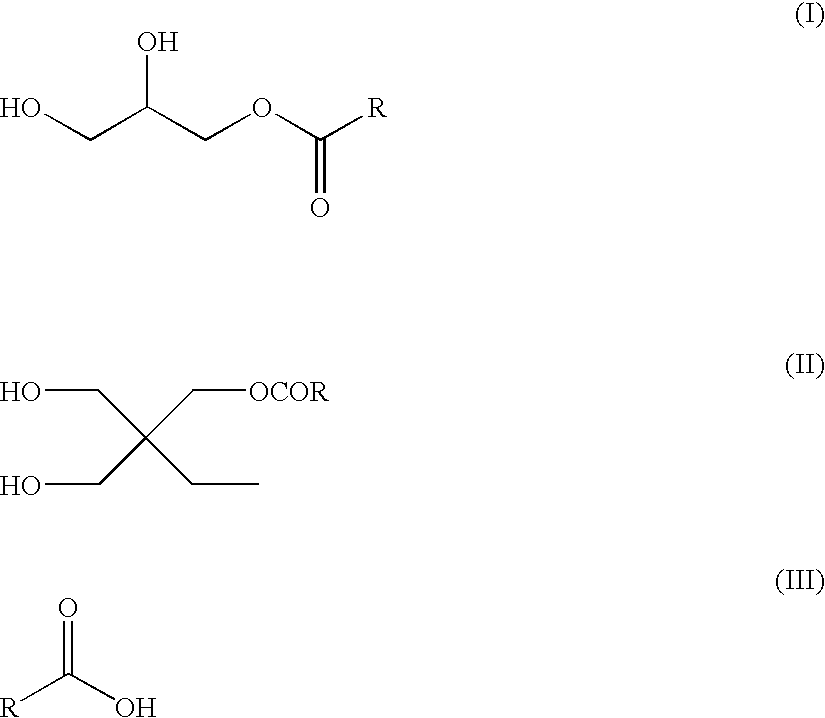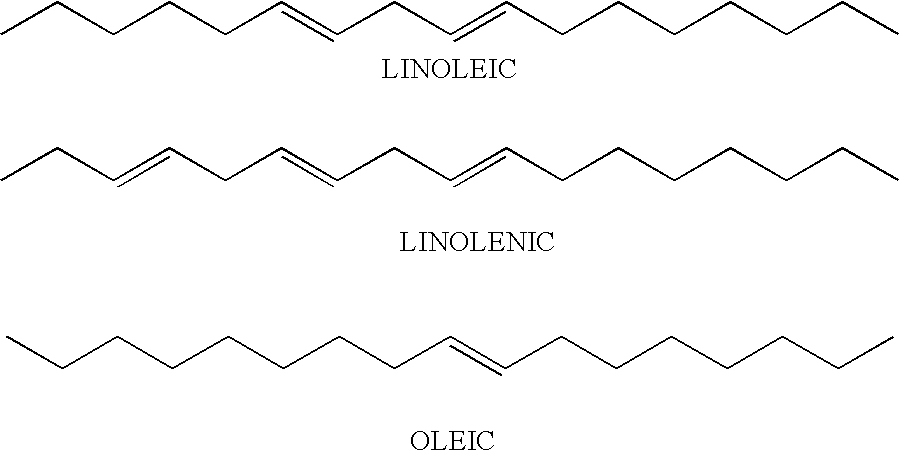Small-particle latex compositions based on waterborne alkyd seeds
a technology of waterborne alkyd seeds and compositions, applied in the field of small particle size aqueous latex polymer dispersion compositions, can solve the problems of poor block resistance, large residual monomer content, dirt pick-up, etc., and achieve the effects of improving film forming properties, small particle size, and low residual monomer conten
- Summary
- Abstract
- Description
- Claims
- Application Information
AI Technical Summary
Benefits of technology
Problems solved by technology
Method used
Image
Examples
example 1
Preparation of an NPG / SIP Adduct
To a 3-L three-neck, round-bottom flask equipped with a mechanical stirrer, a steam-jacketed partial condenser, a Dean-Stark trap, a water condenser, and a nitrogen inlet were charged neopentyl glycol (NPG) 827.0 g (7.95 mole), 5-SSIPA 535.6 g (2.00 mole), Fascat 4100 (1.1 g), and water 91.9 g. The mixture was allowed to react at 140-190° C. and the distillate collected. The reaction was continued until an acid number of 2.3 mg KOH / g was obtained. The resulting adduct was cooled to 120° C. and isolated neat. Water may also be added to yield an adduct having 90% solids.
example 2
Preparation of SSIPA Alkyd 1
To a 500 mL three-neck, round-bottom flask equipped with a mechanical stirrer, a steam-jacketed partial condenser, a Dean-Stark trap, a water condenser, and a nitrogen inlet were charged pentaerythritol (PE) 21.52 g (0.16 mole), trimethylolpropane (TMP) 69.74 g (0.52 mole), the NPG / SIP adduct of Example 1 (90% in water) 164.00 g, isophthalic acid (IPA) 123.25 g (0.74 mole), maleic anhydride (MA) 11.36 g (0.12 mole), Pamolyn 200 (generic name, available from Eastman Chemical Company, Kingsport, Tenn.) 259.38 g (0.89 mole), and Fascat 4100 0.46 g. The reaction temperature was gradually raised to 150° C. in 30 min. and the water distillate collected (12 mL). The reaction was allowed to continue at 170° C. for 30 min., 200 C for 30 min., and 228° C. for two hours until an acid number of 15 mg KOH / g was obtained (condensate 65 mL). The resulting viscous resin was allowed to cool to 150° C. and slowly poured into 500 g of stirred water. The mixing was allowed...
example 3
illustrates the preparation of an aqueous latex dispersion using 5 phr (parts per hundred of the ethylenically unsaturated monomers) SSIPA Alkyd 1 as the seed for emulsion polymerization. (Alkyd / Acrylic=4.8 / 95.2 weight %). The SSIPA alkyd used was a scaled-up batch of Example 2 having 48% solids. The calculated overall Tg of the acrylic monomers is 30° C.
To a 1-L water-jacketed kettle equipped with a mechanical stirrer, a water condenser, a nitrogen inlet, and reactant feeding tubes were added SSIPA Alkyd 1 dispersion (from Example 2,48% solids) 36.82 g and water 445.26 g. Separately, three solutions were prepared in the flasks-1) an initiator solution of ammonium persulfate 0.80 g, ammonium carbonate 0.88 g, and water 24.01 g, 2) a kicker solution of ammonium persulfate 0.80 g and water 11.64 g, and 3) a monomer mixture of methyl methacrylate 191.61 g, n-butyl acrylate 154.84 g, methacrylic acid 7.07 g, and a chain transfer agent, isooctyl 3-mercaptopropionate (IOMP), 1.77 g. The ...
PUM
| Property | Measurement | Unit |
|---|---|---|
| weight percent | aaaaa | aaaaa |
| weight percent | aaaaa | aaaaa |
| weight percent | aaaaa | aaaaa |
Abstract
Description
Claims
Application Information
 Login to View More
Login to View More - R&D
- Intellectual Property
- Life Sciences
- Materials
- Tech Scout
- Unparalleled Data Quality
- Higher Quality Content
- 60% Fewer Hallucinations
Browse by: Latest US Patents, China's latest patents, Technical Efficacy Thesaurus, Application Domain, Technology Topic, Popular Technical Reports.
© 2025 PatSnap. All rights reserved.Legal|Privacy policy|Modern Slavery Act Transparency Statement|Sitemap|About US| Contact US: help@patsnap.com



